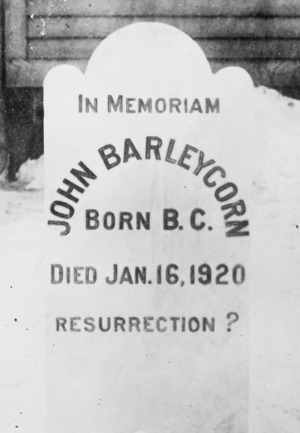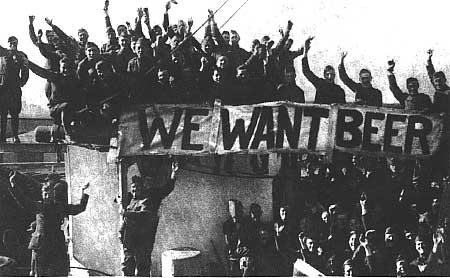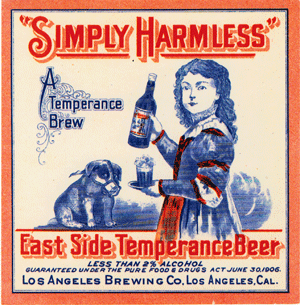[an error occurred while processing this directive]
Antique Beer Photos:

Dozens of prints available in a variety of sizes up to 40x50. |  |
|
|
Reprinted from All About Beer by permission of the author.
We Want Beer: Prohibition And The Will To Imbibe - Part 1.
by Carl Miller
 Nobody could hazard a guess
at how many thousands of mugs of beer had been served over the old mahogany
bar at Weis Brothers Saloon. Bartender John Mich, who had manned the beer
taps at the Milwaukee watering hole since the 1890s, probably could have
come closest in his estimate if he had tried. But it seemed only a matter
of trivia now for the 20 or so patrons gathered in the back room of the
establishment. After all, there was a funeral at hand. They had come together
to pay their final respects to their beloved old friend, John Barleycorn. Nobody could hazard a guess
at how many thousands of mugs of beer had been served over the old mahogany
bar at Weis Brothers Saloon. Bartender John Mich, who had manned the beer
taps at the Milwaukee watering hole since the 1890s, probably could have
come closest in his estimate if he had tried. But it seemed only a matter
of trivia now for the 20 or so patrons gathered in the back room of the
establishment. After all, there was a funeral at hand. They had come together
to pay their final respects to their beloved old friend, John Barleycorn.
None in attendance was consoled by the fact that the dearly
departed was a mere character of fiction, immortalized in song as the mythical
personification of beer. On the contrary, as the ceremony began, some stifled
tears, including Mich, whose moans and gurgles were loudest. With hands
folded and heads bowed, the somber group encircled the casket, which was
artfully decorated with floral tributes placed inside beer mugs and lit
candles stuck in liquor bottles.
Saloon employee William Graf delivered
the eulogy. "John Barleycorn was foully murdered," thundered Graf, "and
his body found in the back yard of legislation!"
The black-dressed pallbearers then carried John Barleycorn's
earthly remains out of the saloon to the nearby banks of the Milwaukee
River. Accompanied by a soft chorus of "Sweet Adeline," they lowered the
casket into the water. (That his final resting place be eternally wet seemed
only fitting.)
Empty beer bottles, for lack of roses, were tossed in after
the sinking casket. The loud splash of the saloon's cash register being
hurled into the river punctuated the ceremony's conclusion.
The passing of John Barleycorn, of course, meant the demise
of Weis Brothers Saloon and thousands just like it all over America. For
beer drinkers everywhere, the taps would soon run dry. The year was 1919
and the nation had just ratified what later historians would call "the
noble experiment." Within one year, National Prohibition would officially
be under way.
Dry Roots Run Deep
Though culminating on January 16, 1920, National Prohibition
was not, by any means, a 20th-century invention. Efforts to curb, if not
eliminate, the national thirst for alcoholic beverages are nearly as old
as America itself. Most of the earliest temperance initiatives were born
of religious circles, the salvation of the individual drinker being at
the heart of their objective. By the early 1800s, however, a more organized
approach had emerged. Temperance societies sprang up in virtually every
city in America, and their collective enrollment reached more than 1 million
members by 1840.

A group known as The Washingtonians gained particular
notoriety. The organization's strength lay in the fact that its membership
was composed entirely of "reformed drunkards," thus
adding a certain potency to its admonitions against drink. Ironically,
few found any significance in the well-known truth that the club's namesake,
old George Washington himself, was a homebrewer and a lover of good porter.
Indeed, throughout the 18th and 19th centuries, the beer
drinker was not a priority target of the temperance crusade. Rather, most
of the crusaders saw whiskey and other distilled spirits as the primary
menace. Many activists even pointed to beer as a possible solution to "the
drink problem," as they called it. In 1784, when Dr. Benjamin Rush published
An Inquiry into the Effects of Spirituous Liquors upon the Human Body and
Mind, he preached that, while distilled spirits were a sure path to self-destruction,
the daily consumption of beer promoted good health and nutrition.
But the temperance advocates' distinction between the
various grades of alcoholic beverages would soon begin to wane. By the
mid- to late-1800s, activists had almost unanimously shifted their efforts
away from the individual drinker, focusing instead on what they viewed
as the epicenter of the problem: the American saloon. After all, the saloon
was ground zero, the very "gateway to hell." It was where a man went in
sober and came out drunk. Gambling, prostitution, under-age drinking—they
were all products of the saloon, according to the new temperance gospel.
In 1874, the Women's Christian Temperance Union was founded
in Cleveland, and with it was born "the visitation band." Much feared by
saloon keepers and beer drinkers alike, the visitation band was an often
vicious mob of Bible-swinging women assembled to descend upon saloons and
verbally accost their patrons. The goal, of course, was to empty the place
and cause financial ruin for the owner. With the patronage sent scrambling,
a team of women was sometimes left behind to block the saloon's entrance,
much to the chagrin of would-be regressors. Only three months after its
founding, the WCTU proudly claimed that it had "called on" more than 1,100
establishments, doing untold damage to the saloon trade.
German immigrants took particular
offense to this type of temperance activity, viewing it as an assault on
their right to practice the customs of their heritage. In many cities,
bands of Germans took to the streets waving steins and carrying beer barrels
on their shoulders in protest. Booming oompa bands usually led the procession,
ensuring that the spectacle was observed by everyone in the vicinity. Often,
the passionate nature of the demonstration was too much for temperance
onlookers to bear, and a confrontation ensued, sometimes boiling over into
violence. Few things were as dear to the German heart as beer.
Prohibition on the Horizon
The long-term effectiveness of the visitation bands and
similar tactics was questionable at best. But, it was from this movement
that came a pivotal development in the temperance movement—the founding
of the Anti-Saloon League.
Established in 1893, the League ultimately proved to be
the single most important force in bringing about National Prohibition.
Its organizers understood that good old-fashioned politics was the only
sure path to victory for their cause. The League conducted no saloon raids,
led no prayers for the drunkard's salvation, and beleaguered no one into
sobriety. Its singular goal was sheer political might. The League's 5 million
members worked relentlessly to support any candidate for office who proclaimed
himself a "dry." But they worked twice as hard against any office-seeker
on the "wet" side of the fence.
The Anti-Saloon League's first real test of strength came
in 1913 when thousands marched on Washington and presented Congress with
petitions calling for a Constitutional Amendment for National Prohibition.
The petitions made their way through the governmental labyrinth, surfacing
in 1915 as a bill to be voted on by the House of Representatives. The vote
was 197 in favor, 190 against. Though not the required two-thirds majority,
the outcome astonished everyone. It was a clear indication that Prohibition
was, for the first time, well within reach. The League soon proclaimed
itself "the strongest political organization in the world."
Despite the political successes, it was generally well
known that the majority of Americans did not support Prohibition. The beer-drinking,
saloon-going population simply had no equally potent organization working
on their behalf. There was no wet political machine to lobby government,
publish literature, raise funds, or campaign for political candidates—all
of the activities in which the League was so proficient.
One of the few potentially viable contenders that did
challenge the League was the German-American Alliance, whose members numbered
2 million by 1914. Seeking to preserve the German immigrant's right to
have his beer, the Alliance appealed to the American sense of freedom,
stressing to lawmakers that Prohibition took away the individual's choice.
War in Europe, however, ultimately sent the organization down in flames.
Amid growing anti-German sentiment in America, the Alliance was charged
by Congress with conducting itself in an unpatriotic manner and was ordered
to disband in 1918.
Of course, the brewers themselves mounted a vigorous assault
on the dry campaign. Their vast financial resources and strong voice in
Washington were formidable weapons. But the brewers' message lacked a sense
of sincerity, and their efforts often came off as blatantly self-serving.
Then, too, introduction of the federal income tax in 1913 dealt the brewers
a serious blow. The new tax removed government's reliance on revenue from
beer taxes, thereby obliterating one of the brewers' most compelling defenses
against Prohibition. Woman suffrage and World War I also conspired against
the brewers. Naturally, the Anti-Saloon League exploited these opportunities
with insidious precision.
In the end, the power of the dry juggernaut simply could
not be matched by any wet faction. On January 16, 1919, Nebraska became
the required 36th state to ratify the Eighteenth Amendment to the Constitution.
National Prohibition began exactly one year later.
 To Obey, or Not to Obey To Obey, or Not to Obey
Prohibition has been called "the noble experiment"—experiment
being the key word. Among the most enduring arguments against a nationwide
dry law was that enforcement would be problematic at best, impossible at
worst. And so, even the most ardent supporters of the Amendment, whether they admitted
it or not, awaited those first dry weeks with bated breath. The big question:
Would Prohibition actually prohibit?
The beer-drinking population of America was one group
that was particularly disinclined to bow to unpopular legislation. In Milwaukee,
the very beer Mecca of the nation, fear of disobedience on the eve of Prohibition
was so great that the city's Prohibition commissioner ordered all remaining
outdoor beer advertisements to be painted over, so as not to incite temptation.
Indeed, the fear of rampant civil disobedience was justified. The public
consensus, after all, was that beer ought to be excluded from the dry law,
particularly beer of low alcohol content.
Colonel Jacob Ruppert, a New York beer baron and owner
of the New York Yankees, led the charge on this conviction. He asserted
that beer that contained 2.75 percent alcohol or less could not be considered
intoxicating. The colonel took his argument all the way to the Supreme
Court but was ultimately defeated.
The Prohibition Amendment itself made no reference to
alcohol content, citing only "intoxicating liquors for beverage purposes"
as being illegal. But the resulting Volstead Act (the actual set of laws
drafted by Congress to enforce Prohibition) set the legal alcohol limit
at one-half of 1 percent. Brewers and beer drinkers alike bristled at the
low limit, which, according to one frustrated observer, was "less than
the alcohol content of sauerkraut." The debate escalated when it was revealed
that Congress had not selected the legal limit based on any chemical or
scientific data on the properties of intoxication. Instead, the figure
was simply borrowed from the Internal Revenue Service, which used it to
distinguish a taxable malt beverage from a nontaxable one.
Organized protests among the nation's beer drinkers were
inevitable. Led by Samuel Gompers, head of the American Federation of Labor,
thousands marched on Washington in June of 1919 to demand the exemption
of beer from the Prohibition laws. Gompers pointed out that the Eighteenth
Amendment represented the first instance in American history when the United
States Constitution actually denied rights, instead of granting them. A
similar demonstration was held in New York City, where some 20,000 protesters
marched down Fifth Avenue on July 4th. One banner read, "Dempsey knocked
out Carpenter in four rounds. Let's knock out Prohibition in four weeks!"
Troops returning home from Europe were particularly vocal
in their cries for beer. While off fighting for liberty in foreign lands,
their freedoms at home had suffered a brutal attack. In March of 1919,
a soldier transport ship arrived in New York harbor with its troops all
chanting, "We Want Beer." A sympathetic brass band playing on one of the
welcome vessels answered the chant with a rendition of "How Dry I Am."
Ultimately, however, all
of the protests and objections went unheard, and beer containing more than
one-half of 1 percent of alcohol remained illegal throughout Prohibition.
America's beer drinkers, it seemed, would be forced to find new ways to
have their beer. And that they did.
Thou Shalt Have Beer
Homebrew, or heimgemacht as the Germans called it, became
all the rage during Prohibition. Manufacturers of malt syrup (an essential
ingredient for homebrewers) reported torrential sales, and many former
breweries found financial refuge makig it as well.
By 1929, the Prohibition Bureau estimated the illicit
production of homebrew at 22 million barrels (31 gallons per barrel) annually,
nearly the same amount of legal beer sold in 1919. In some cities, so much
homebrew was being made that sewer systems were choked beyond
function by the onslaught of spent hops.
One clever poet painted a colorful, though not too inaccurate,
picture of the typical Prohibition-era household:
Mother's in the kitchen, washing out the jugs;
Sister's in the pantry, bottling the suds;
Father's in the cellar, mixing up the hops;
Johnny's on the porch, watching for the cops.
Alternatives to the Real Stuff
For the man not too handy with the homebrew, there were
other alternatives. Hundreds of brewers across the country were licensed
to produce "near beer", made by brewing real beer, then boiling off the
alcohol to conform to the one-half of 1 percent limit. Not surprisingly,
a goodly share of the real stuff never made it to the de-alcoholizer, either
by clever deceit of the brewer or by greed of the crooked Prohibition agent.
Even when de-alcoholized according to the letter of the
law, near beer was often delivered to customers with a separate package
containing a portion of the raw alcohol boiled off. The
drinker then squirted the alcohol back into the near beer with a syringe,
thus making what was commonly called "needle beer."
Plain old near beer, after all, appealed to no one. A
popular quip of the day said it best: "Whoever called
it near beer was a poor judge of distance!" While homebrew and spiked near
beer quenched the thirst of households, it was bootleggers and smugglers
who lubricated the booming "speakeasy" trade. In New York City alone, about
32,000 speakeasies were open for business in 1929, compared to half that
number of legal saloons before Prohibition. The flow of real beer from
old-time breweries now controlled by organized crime was never in short
supply. Chicago, in particular, saw little slowdown in beer production
at the onset of Prohibition. Notorious mob figures like Johnny Torrio,
and later Al Capone, kept Chicagoans knee-deep in beer for the duration
of the dry (or not so dry) years.
Indeed, it did not take long for Prohibition's darkest
legacy to emerge. Organized crime syndicates permeated cities throughout
the nation. Turf wars, vengeance killings and rampant political corruption
made daily headlines everywhere. It soon became clear to everyone that
the "noble experiment" was failing miserably, worse than even its harshest
critics had predicted.
Angry Americans—most of whom had sat idly by
while Prohibition became reality—now took up arms against it.
The tide was turning, and the days of National Prohibition were numbered.
Go to Part 2.
Copyright 2000 Carl Miller
|

